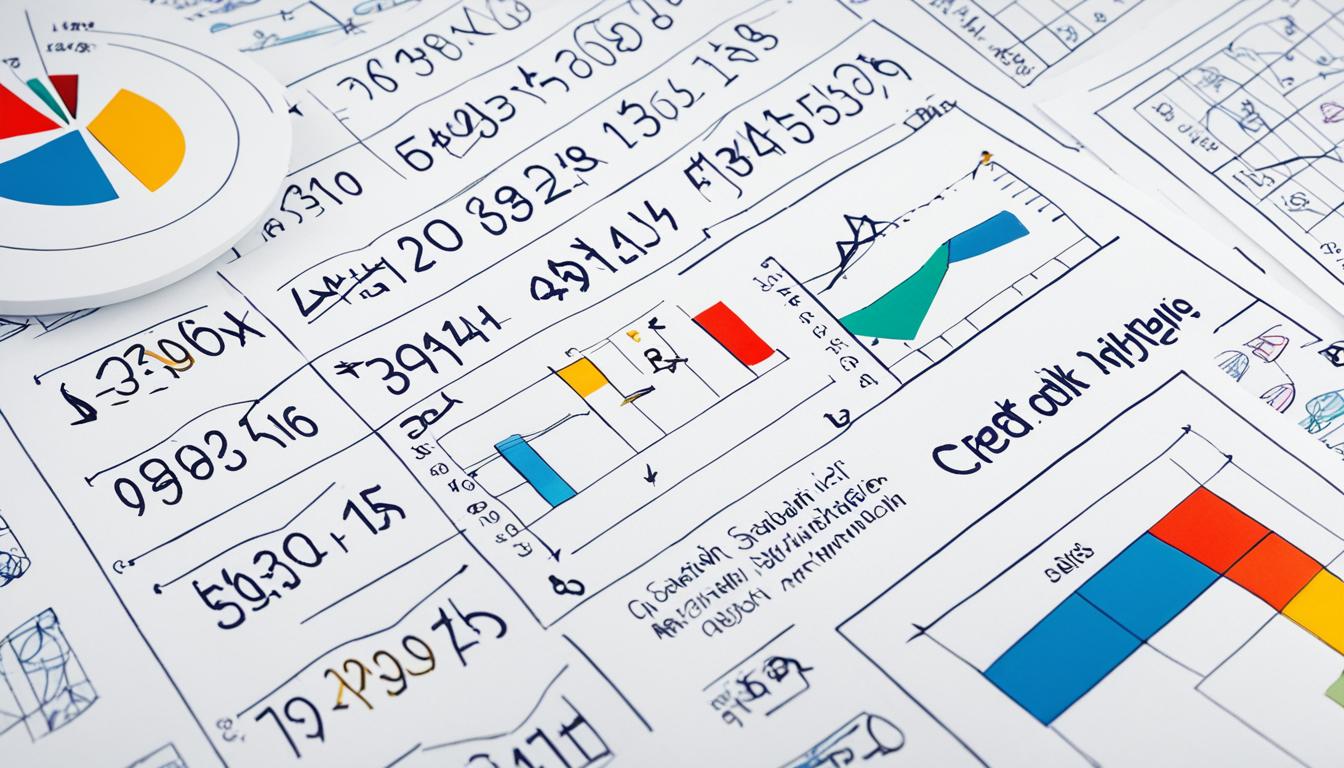Credit Risk Modeling Essentials for Finance
Credit risk modeling is a critical aspect of risk management in financial institutions. It involves the use of statistical and mathematical techniques to assess and quantify potential losses associated with defaulting borrowers or counterparty failures. Understanding credit risk, types of credit risk models, challenges in credit risk modeling, and recent advancements in the field are essential for robust financial risk assessment and management in today’s dynamic marketplaces.
Key Takeaways:
- Credit risk modeling is crucial for effective risk management in financial institutions.
- It involves assessing and quantifying potential losses related to defaulting borrowers or counterparty failures.
- Types of credit risk models include statistical models and structural models.
- Challenges in credit risk modeling include data quality, model risk, tail risk, and portfolio dynamics.
- Advancements in credit risk modeling include the use of machine learning, alternative data sources, and network analysis.
Understanding Credit Risk
Credit risk is an inherent risk associated with lending, investing, and trading activities. It refers to the possibility that a borrower or counterparty may fail to fulfill their contractual obligations, leading to financial losses for the lender or investor. To effectively manage credit risk, financial institutions employ credit risk modeling techniques.
The primary objective of credit risk modeling is to estimate two critical parameters: the probability of default (PD) and the potential loss given default (LGD). The PD represents the likelihood of a borrower defaulting within a specific timeframe, while the LGD measures the expected loss if a default occurs. These parameters, along with the exposure at default (EAD), which indicates the amount at risk when a default happens, form the foundation of credit risk modeling.
By accurately estimating credit risk, financial institutions can make informed decisions regarding lending, pricing, and portfolio management. Credit risk modeling allows them to assess the potential impact of defaulting borrowers or counterparty failures and develop strategies to mitigate these risks. Robust credit risk modeling enhances risk assessment, aids in setting appropriate capital requirements, and contributes to overall risk management.
Credit Risk Modeling Parameters
Credit risk modeling relies on multiple parameters to assess credit risk effectively. The three primary parameters are:
- Probability of Default (PD): The probability that a borrower will default within a specific timeframe. It quantifies the likelihood of default for individual borrowers or counterparties.
- Potential Loss Given Default (LGD): The expected loss if a borrower or counterparty defaults. It helps financial institutions assess the potential impact of default events.
- Exposure at Default (EAD): The amount at risk when a borrower or counterparty defaults. It represents the financial exposure that lenders or investors face if default occurs.
These parameters are crucial in credit risk modeling as they provide insights into the likelihood and potential impact of credit events, enabling institutions to make informed decisions and develop effective risk mitigation strategies.
Types of Credit Risk Models
Credit risk models play a crucial role in assessing and managing credit risk in financial institutions. These models can be broadly classified into two main types: statistical models and structural models.
Statistical models rely on historical data to estimate the probability of default and potential losses. They analyze past borrower behavior and other relevant factors to predict the likelihood of default. Within statistical models, there are two subcategories commonly used in credit risk modeling: discriminant models and survival models.
Discriminant models utilize statistical techniques to differentiate between defaulters and non-defaulters based on observable factors such as income, assets, and credit history. They assign a probability of default to each borrower and classify them accordingly.
Survival models, on the other hand, focus on analyzing time-to-default data. They consider the time it takes for a borrower to default, incorporating important time-related variables into their calculations. These models are particularly useful for estimating the probability of default over a specific period.
Structural models, in contrast, take a different approach by focusing on the underlying dynamics of a borrower’s assets and liabilities. One well-known structural model is the Merton model, which estimates default probabilities by assessing the relationship between a borrower’s asset value and their outstanding debt. These models also help determine appropriate capital allocations for credit portfolios.
Both statistical and structural models have their advantages and limitations, and financial institutions often use a combination of both to gain a comprehensive understanding of credit risk. By utilizing these models, institutions can make informed decisions, allocate capital effectively, and mitigate credit risk.
Benefits of Statistical and Structural Models
Statistical models offer the advantage of using historical data to estimate credit risk, taking into account past borrower behavior and other relevant factors. They provide a quantitative measure of credit risk based on empirical evidence, allowing financial institutions to assess risk within their portfolios.
On the other hand, structural models provide insights into the underlying dynamics of a borrower’s financial position. By considering asset values and liabilities, these models offer a more holistic view of credit risk and can help institutions better understand the factors driving default probabilities.
“Credit risk models can be broadly classified into two main types: statistical models and structural models. Statistical models rely on historical data to estimate the probability of default and potential losses. Structural models focus on the underlying dynamics of a borrower’s assets and liabilities.”
Overall, credit risk modeling is a vital tool for financial institutions to effectively assess, manage, and mitigate credit risk. By employing a combination of statistical and structural models, institutions can gain a deeper understanding of credit risk, make informed decisions, and ensure the stability and profitability of their operations.
Challenges in Credit Risk Modeling
Credit risk modeling is a crucial aspect of risk assessment in financial institutions. However, it comes with its fair share of challenges that practitioners need to navigate. Addressing these challenges is essential to ensure accurate and reliable risk assessments.
- Data quality and availability: High-quality data is the foundation of credit risk modeling. However, obtaining reliable and comprehensive data can be a challenge. The accuracy and completeness of the data used directly impact the accuracy of the risk assessment and the overall effectiveness of the model.
- Assumptions and model risk: Credit risk models are based on certain assumptions about borrower behavior and market conditions. However, the accuracy of these assumptions is crucial, as deviations from reality can lead to inaccurate predictions. Model risk arises when these assumptions are not correctly incorporated into the model.
- Tail risk and extreme events: Capturing tail risk, which refers to the likelihood of rare and extreme events, is challenging. Traditional credit risk models may struggle to accurately predict the impact of unprecedented events or severe economic downturns. Assessing and incorporating tail risk into credit risk models is crucial for comprehensive risk assessment and management.
- Portfolio dynamics and correlations: Modeling the dynamics of credit portfolios and understanding the correlation between different assets is a complex task. The interconnectedness of various borrowers and market factors adds another layer of complexity to credit risk modeling. Properly capturing portfolio dynamics and correlations is essential for accurate risk assessments and effective portfolio management.
Overcoming these challenges requires a combination of robust data management processes, thorough model validation, and the incorporation of advanced techniques and methodologies.
Recent Advancements in Credit Risk Modeling
In recent years, the field of credit risk modeling has witnessed significant advancements fueled by technology and data analytics. These advancements have revolutionized the way credit risk is assessed and managed in financial institutions.
One of the groundbreaking developments in credit risk modeling is the integration of machine learning and artificial intelligence techniques. These advanced techniques enable the handling of vast amounts of data and the identification of complex patterns that were previously challenging to detect. By leveraging machine learning algorithms, credit risk models can now make more accurate predictions and generate actionable insights.
Moreover, alternative data sources have emerged as a valuable addition to credit risk modeling. Traditionally, credit risk assessments heavily relied on financial and demographic data. However, with the advent of alternative data sources, such as social media data and satellite imagery, lenders can gain additional insights into borrower behavior and creditworthiness. This allows for a more comprehensive and nuanced evaluation of credit risk.
Network analysis is another area that has transformed credit risk modeling. Traditional credit risk models often focused on individual borrowers in isolation. However, in today’s interconnected world, considering the interdependencies and systemic risks is crucial. Network analysis techniques enable lenders to evaluate credit risk at a holistic level by examining the relationships between borrowers, lenders, and other stakeholders. This approach provides a more comprehensive assessment of credit risk and facilitates better risk management decisions.
These recent advancements in credit risk modeling have had a profound impact on risk assessments and decision-making within the financial industry. Financial institutions that embrace these technologies and incorporate alternative data sources and network analysis into their models gain a competitive edge in risk management. Such institutions can make more informed decisions, adapt to changing credit landscapes, and effectively mitigate credit risk.
Basel Regulations
Basel regulations play a crucial role in the banking industry, ensuring that financial institutions have sufficient capital to handle credit risk effectively. They provide a framework for assessing and managing risks, promoting stability and confidence in the global financial system.
The first set of Basel regulations, known as Basel I, was introduced in 1988. Its primary focus was credit risk, aiming to ensure that banks maintain a minimum level of capital adequacy to absorb potential losses. One of the key concepts introduced by Basel I is the capital adequacy ratio, which assesses a bank’s capital in relation to its risk exposure.
Building upon the foundation established by Basel I, the Basel II accord was introduced in 2004. Basel II expanded the scope of regulations to include not only credit risk but also operational and market risk. It introduced different approaches for estimating credit risk, such as the standardized approach and the internal rating-based (IRB) approach. These approaches allow banks to tailor their risk assessments based on their own internal models and historical data.
Looking ahead, Basel III is scheduled for implementation in 2023. This latest iteration of the regulations incorporates additional risk measures and emphasizes even greater capital standards. It introduces liquidity requirements, stress testing, and the notion of tangible equity capital. The goal is to enhance the resilience of banks and promote stability in the face of unforeseen events and economic downturns.
Here is an overview of the key Basel regulations:
| Basel Regulations | Year Introduced | Main Focus |
|---|---|---|
| Basel I | 1988 | Credit Risk and Capital Adequacy Ratio |
| Basel II | 2004 | Credit, Operational, and Market Risk |
| Basel III | 2023 (Scheduled) | Additional Risk Measures and Capital Standards |
These Basel regulations have had a significant impact on the banking industry, shaping risk management practices and influencing how institutions allocate capital. By adhering to these regulations, banks can enhance their resilience, protect against credit risk, and contribute to the overall stability of the financial system.
IFRS 9
IFRS 9 is an International Financial Reporting Standard that addresses accounting for financial instruments, including credit risk. It replaces IAS 39 and focuses on the expected loss model, which encompasses future losses. In IFRS 9, credit risk is assessed based on three stages:
- Stage 1: This stage represents the initial recognition of a financial asset. At this stage, the credit risk has not increased significantly.
- Stage 2: In this stage, the credit risk has increased significantly since initial recognition. It requires a greater level of monitoring and provision for expected losses.
- Stage 3: This stage indicates a permanent reduction in the value of the financial asset. It requires specific provisions for credit losses and a reassessment of the cash flow.
The expected loss model of IFRS 9 enables financial institutions to have a forward-looking approach to credit risk assessment. By incorporating future losses into the accounting process, it provides a more accurate representation of a company’s financial position. This helps stakeholders make informed decisions and assess the creditworthiness of an organization.
Implementing IFRS 9 requires financial institutions to carefully analyze their credit risk exposure and adopt appropriate risk management strategies to mitigate potential losses. By adhering to the guidelines of IFRS 9, organizations can ensure transparency and consistency in their financial reporting, thereby enhancing trust and credibility among investors and stakeholders.
Factors Affecting Credit Risk Modeling
When it comes to credit risk modeling and the assessment of credit risk, several factors come into play. These factors help lenders understand and mitigate the risks associated with lending and investing. Three crucial factors that significantly impact credit risk modeling are:
- Probability of Default (PD): The Probability of Default (PD) is a key metric used to measure the likelihood that a borrower will default on their loan or fail to meet their financial obligations. Credit risk models analyze various factors such as financial ratios, credit history, and industry trends to estimate the PD for individual borrowers or counterparty.
- Loss Given Default (LGD): Loss Given Default (LGD) represents the potential loss that a lender or investor may incur if a borrower defaults on their loan. LGD takes into account factors such as collateral value, recovery rates, and legal and administrative costs associated with the default. It helps lenders evaluate the financial impact of potential defaults and make informed decisions.
- Exposure at Default (EAD): Exposure at Default (EAD) is a measure of the financial exposure that a lender faces at the time of default. It assesses the total amount of funds lent or invested and determines the potential loss in case of default. EAD considers factors such as outstanding loan balance, unused credit lines, and off-balance sheet exposures to calculate the total exposure.
These factors, along with others such as credit rating, creditworthiness, and macroeconomic conditions, play a critical role in credit risk modeling. By analyzing PD, LGD, and EAD, lenders can effectively assess and quantify the risks associated with their credit portfolios, enabling them to make informed decisions and allocate capital efficiently.
Types of Credit Risk
Different types of credit risk can significantly impact both lenders and borrowers in various ways. It is crucial to understand and recognize these different types of credit risk to effectively manage and mitigate potential risks. The three primary types of credit risk are:
Credit Default Risk
Credit default risk occurs when a borrower fails to fulfill their debt obligations, resulting in financial losses for the lender. This type of risk is a fundamental aspect of credit risk management and is assessed by evaluating the probability of default (PD) and the potential loss given default (LGD).
Concentration Risk
Concentration risk refers to the risk associated with having a significant exposure to a single counterparty, industry sector, or geographic region. Overreliance on a single borrower or sector can lead to substantial losses if that borrower or sector experiences financial distress or bankruptcy. Diversification is an essential strategy to mitigate concentration risk and protect against unexpected events.
Country Risk
Country risk arises from political instability, economic conditions, and regulatory changes in a particular country. It affects the value of assets, operating profits, and the general business environment. Lenders and investors need to carefully assess and monitor country risk when engaging in cross-border transactions or investing in foreign markets.
“Managing credit risk requires a deep understanding of the different types of credit risk that can impact lenders and borrowers. By correctly identifying and assessing credit default risk, concentration risk, and country risk, financial institutions can make informed decisions and implement effective risk management strategies.”
By recognizing and understanding these types of credit risk, financial institutions can formulate comprehensive risk management strategies and make informed decisions regarding lending, investing, and trading activities.
Conclusion
Effective credit risk modeling is indispensable for financial institutions in managing credit risk and ensuring sound risk management practices. By implementing sophisticated models and methodologies, these institutions can make well-informed decisions, optimize capital allocation, and adhere to regulatory requirements.
However, credit risk modeling also poses challenges that need to be addressed for accurate risk assessment. Data quality and availability play a crucial role in ensuring the reliability of credit risk models. Furthermore, the assumptions made within these models introduce the potential for model risk, highlighting the importance of comprehensive validation processes.
Tail risk and portfolio dynamics further complicate credit risk modeling, as capturing extreme events and understanding the interconnectedness of various assets and liabilities is essential. Nevertheless, with advancements in technology and data analytics, credit risk modeling continues to evolve.
Machine learning techniques, alternative data sources, and network analysis offer new avenues for enhancing risk assessments and decision-making in the ever-changing credit landscape. By embracing these advancements, financial institutions can stay ahead and effectively manage credit risk to safeguard their financial well-being.







